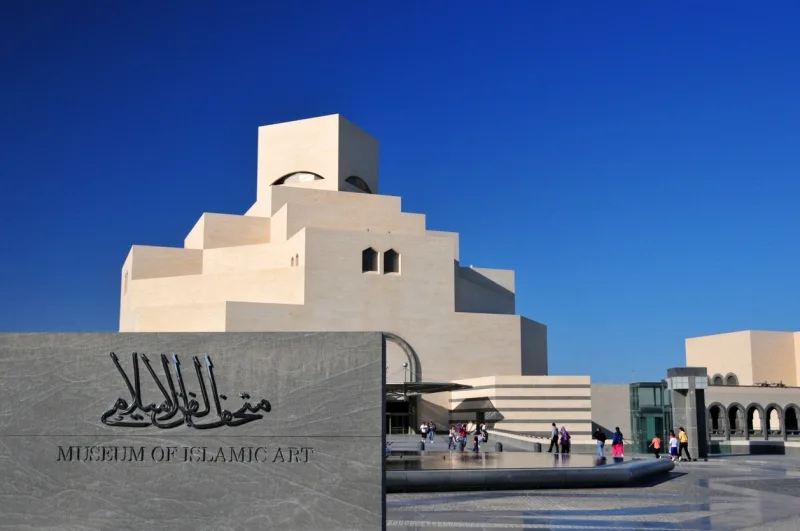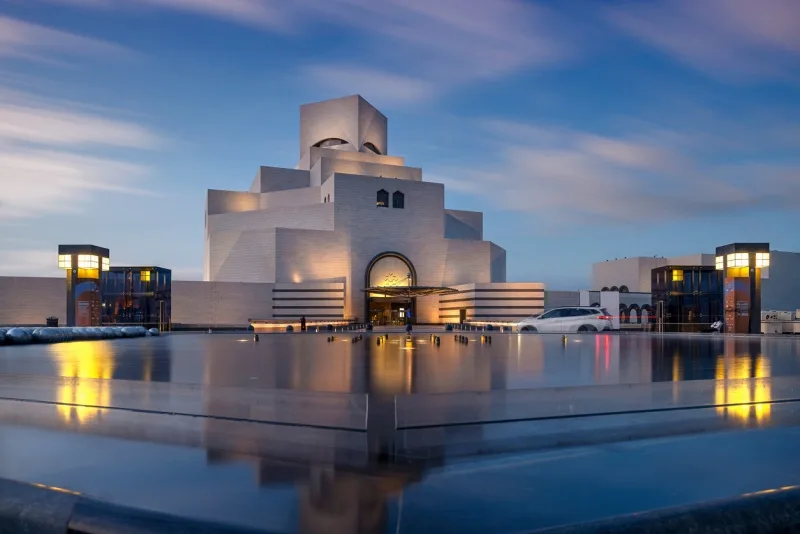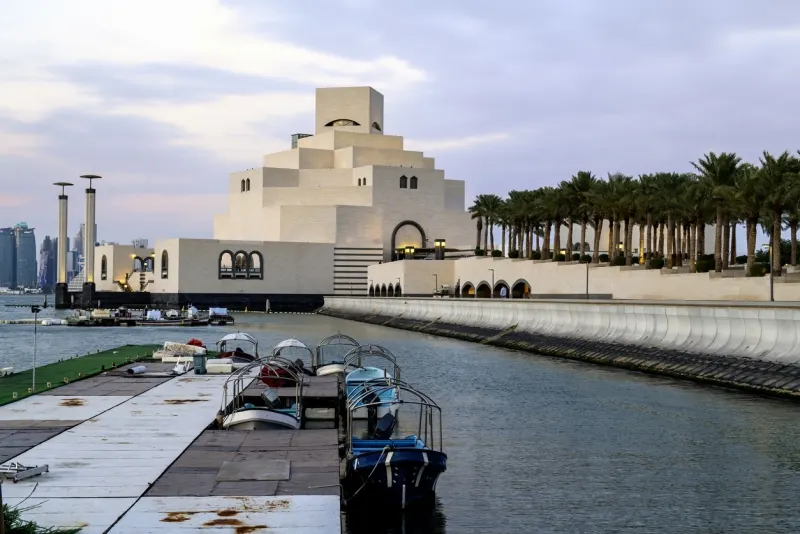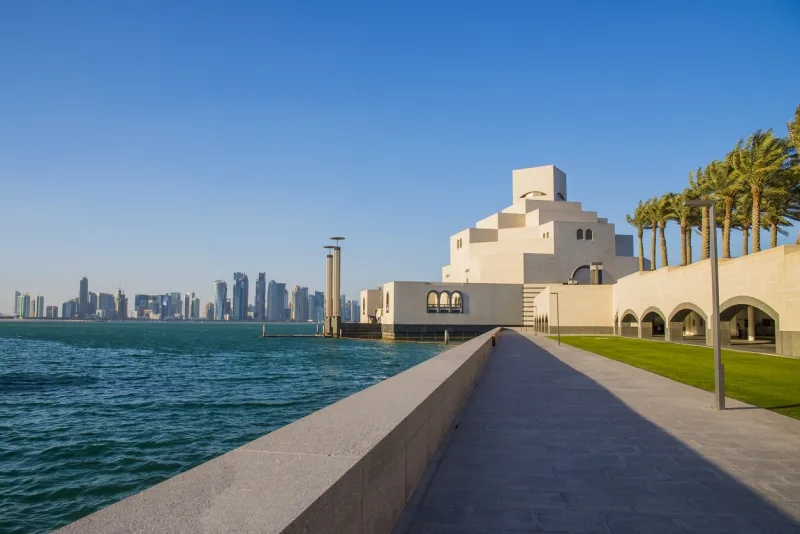Museum of Islamic Art
.jpg)
The Museum of Islamic Art stands as a breathtaking architectural marvel on Doha’s waterfront, capturing the essence of Islamic design through the visionary lens of I.M. Pei. When this legendary architect came out of retirement at 91 to create his final masterpiece, he wasn’t planning a modest farewell. Rising from its own artificial island, the museum’s striking geometric facade creates an unforgettable silhouette against Qatar’s skyline.
Inside, the museum houses one of the world’s most comprehensive collections of Islamic artifacts spanning three continents and 1,400 years of history. After its 2022 renovation, it has become more engaging and accessible than ever. From the exquisite IDAM restaurant to the scenic MIA Park featuring Richard Serra’s towering sculpture, this cultural gem offers much more than just gallery spaces. This 2025 guide takes you through everything you need to know before visiting this iconic institution.
A Modern Icon in the Heart of Doha
Perched on its own artificial island, the Museum of Islamic Art occupies a commanding position at one end of Doha’s seven-kilometer-long Corniche. I.M. Pei specifically requested the museum be built offshore to preserve its isolation and ensure unobstructed views of the city and the Gulf.
Visitors approach through a beautifully landscaped park featuring fountains, tree-lined boulevards, and bridges that connect the island to the mainland. The museum overlooks the traditional dhow harbor, offering views that celebrate Qatar’s maritime heritage. Surrounding the museum is MIA Park, a vast green space filled with cafés, markets, film screenings, and community events — making it a lively hub for locals and tourists alike.
Why It Stands Out on the Corniche
The Museum of Islamic Art is instantly recognizable thanks to its geometric design, cream-colored limestone facade, and strategic positioning. Its limestone exterior, imported from France, captures the shifting desert light throughout the day, while a massive north-facing window offers panoramic views of Doha Bay.
In 2022, it became the first carbon-neutral museum in the Middle East, reinforcing Qatar’s commitment to sustainability. I.M. Pei’s decision to situate it offshore ensured that no future development would obstruct the views or interfere with the building’s dramatic relationship with sunlight.
The Role of Qatar Museums
The Museum of Islamic Art was one of the first major projects of Qatar Museums, the country’s leading cultural organization. Since its opening in 2008, it has played a key role in Qatar’s cultural vision, serving as both a national treasure and an international landmark. Beyond its galleries, the museum regularly participates in educational programs, exhibitions, and sustainability initiatives, reinforcing its role as a dynamic center of culture and learning.

Inside the Museum: What to See and Do
Stepping inside the Museum of Islamic Art reveals a space that blends architectural grandeur with cultural depth. Visitors can explore world-class galleries, dine in a Michelin-starred restaurant, enjoy outdoor art, or participate in educational workshops.
IDAM Restaurant and Culinary Experiences
Located on the top floor, IDAM is a MICHELIN-starred restaurant created by chef Alain Ducasse. It offers Mediterranean cuisine infused with Arabian flavors in an interior designed by Philippe Starck. Guests enjoy breathtaking views of Doha’s skyline and the Corniche while savoring dishes such as lamb, quail, and signature desserts. IDAM is open Sunday through Thursday for lunch and dinner.
MIA Park and Richard Serra’s Sculpture
Adjacent to the museum, MIA Park serves as a vibrant outdoor space ideal for relaxation and recreation. Families can enjoy playgrounds, biking paths, and open lawns for picnics, while events like movie screenings and markets keep the park lively year-round.
The park’s most iconic feature is “7”, a monumental 80-foot steel sculpture by artist Richard Serra. Composed of seven towering steel plates arranged in a heptagonal formation, it celebrates the spiritual and cultural symbolism of the number seven in Islamic tradition.
Library and Study Rooms
The MIA Library houses over 21,000 books on Islamic art, including more than 2,000 rare volumes. With tranquil reading areas overlooking the water, the library provides an ideal environment for scholars and visitors alike. It’s one of the region’s largest specialized art libraries and welcomes guests six days a week.
Workshops and Public Programs
The museum regularly hosts creative workshops and educational programs for all ages. Children can participate in art sessions like “Little Artist’s Eye,” while adults can explore geometry, calligraphy, and sketching workshops. Programs like “Talented in Kufic Script” and student art competitions encourage creativity and cultural appreciation among the next generation.

The Collection: 1,400 Years of Islamic Art
At the heart of the Museum of Islamic Art lies its extraordinary collection of over 14,000 artifacts representing 1,400 years of Islamic heritage across three continents. Visitors can trace the evolution of Islamic artistry from Spain and North Africa to India and China.
Artifacts from Three Continents
The museum’s artifacts come from both religious and domestic settings, revealing how Islamic aesthetics influenced daily life as well as ceremonial art. Each piece showcases the exchange of ideas and craftsmanship that characterized the Islamic world throughout history.
Ceramics, Textiles, and Metalwork
The collection includes exquisite examples of:
- Ceramics: Decorative tiles, bowls, and vessels used in everyday life and architecture.
- Textiles: Luxurious carpets, fabrics, and garments crafted for royalty and elite patrons.
- Metalwork: Intricately engraved scientific instruments, weapons, and household objects.
- Other materials: Jewelry, wood carvings, coins, and glass objects that reflect cultural diversity.
Rare Manuscripts and the Blue Qur’an
Among the museum’s most prized treasures are its manuscripts. The Abbasid Blue Qur’an, written in gold Kufic script on indigo parchment, is a masterpiece of calligraphic art. The museum also holds pages from the enormous Timurid Baysunghur Qur’an, considered the largest Qur’an ever produced. Other highlights include the illustrated Shahnameh of Shah Tahmasp, one of the greatest works of Persian art.

Customize Your Dream Vacation!
Get in touch with our local experts for an unforgettable journey.
Plan Your Trip
Architecture and Design by I.M. Pei
The Museum of Islamic Art stands as a culmination of I.M. Pei’s architectural genius. At 91, he accepted the challenge of designing a modern Islamic landmark that would respect tradition while embracing innovation.
Pei’s Search for Inspiration
To understand Islamic design principles, Pei traveled across the Muslim world — from Spain to India — studying mosques, palaces, and fortresses. His “aha moment” came in Cairo at the Ibn Tulun Mosque, where he was captivated by the simplicity and geometric purity of its small ablution fountain. This became the conceptual foundation for the museum’s design.
Limestone and Geometric Forms
The building’s cream-colored limestone exterior glows under Doha’s sunlight. Its structure consists of stacked cubes and octagons that ascend toward a central dome. The interplay of geometric forms and light creates a sense of harmony and timelessness.
Interior Masterpieces: Dome and Atrium
Inside, visitors are greeted by a breathtaking 50-meter-high atrium crowned with a faceted dome. A grand double staircase curves elegantly beneath a circular chandelier, leading to the upper galleries. The design evokes both grandeur and spiritual reflection — hallmarks of Islamic architecture.

Renovation and the 2022 Reopening
In preparation for the 2022 FIFA World Cup, the Museum of Islamic Art underwent a major renovation to enhance visitor experience and modernize its facilities.
Purpose of the Renovation
The renovation focused on reimagining the museum’s permanent galleries, improving visitor flow, and enhancing accessibility. Collaborating with the original design firm, the team ensured that I.M. Pei’s architectural integrity remained intact while incorporating modern exhibition techniques.
New Immersive Experiences
The updated museum now features immersive digital experiences, including 3D visualizations of Doha’s development and interactive multimedia displays. Visitors can experience Islamic culture through visual art, soundscapes, and even scents from across the Muslim world.
Family-Friendly Enhancements
The new Family Trail includes 12 interactive stations designed for children to explore Islamic art through play and creativity. The museum also added a dedicated section on Islam in Southeast Asia, highlighting trade, culture, and cross-cultural connections.
Its location on a private island, architectural design by I.M. Pei, and a collection covering 1,400 years of Islamic history make it one of a kind.
You’ll find rare manuscripts, including the Blue Qur’an, along with ceramics, textiles, metalwork, and interactive exhibits showcasing Islamic culture.
Yes, the museum features IDAM, a MICHELIN-starred restaurant offering Mediterranean cuisine with Arabian influences and stunning skyline views.
You can enjoy outdoor events, art workshops, film nights, and admire Richard Serra’s massive sculpture “7” overlooking Doha Bay.
The 2022 renovation introduced digital experiences, a family trail, and new galleries focusing on Southeast Asian Islamic culture.
























